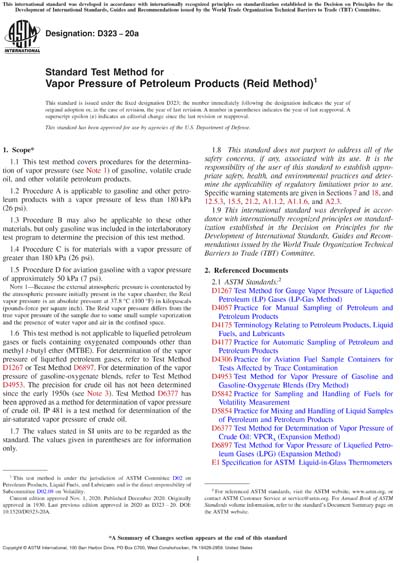Most recent
ASTM D323-20a
Standard Test Method for Vapor Pressure of Petroleum Products (Reid Method)
1.1 This test method covers procedures for the determination of vapor pressure (see Note 1) of gasoline, volatile crude oil, and other volatile petroleum products.
1.2 Procedure A is applicable to gasoline and other petroleum products with a vapor pressure of less than 180 kPa (26 psi).
1.3 Procedure B may also be applicable to these other materials, but only gasoline was included in the interlaboratory test program to determine the precision of this test method.
1.4 Procedure C is for materials with a vapor pressure of greater than 180 kPa (26 psi).
1.5 Procedure D for aviation gasoline with a vapor pressure of approximately 50 kPa (7 psi).
Note 1: Because the external atmospheric pressure is counteracted by the atmospheric pressure initially present in the vapor chamber, the Reid vapor pressure is an absolute pressure at 37.8 °C (100 °F) in kilopascals (pounds-force per square inch). The Reid vapor pressure differs from the true vapor pressure of the sample due to some small sample vaporization and the presence of water vapor and air in the confined space.
1.6 This test method is not applicable to liquefied petroleum gases or fuels containing oxygenated compounds other than methyl t-butyl ether (MTBE). For determination of the vapor pressure of liquefied petroleum gases, refer to Test Method D1267 or Test Method D6897. For determination of the vapor pressure of gasoline-oxygenate blends, refer to Test Method D4953. The precision for crude oil has not been determined since the early 1950s (see Note 3). Test Method D6377 has been approved as a method for determination of vapor pressure of crude oil. IP 481 is a test method for determination of the air-saturated vapor pressure of crude oil.
1.7 The values stated in SI units are to be regarded as the standard. The values given in parentheses are for information only.
1.8 This standard does not purport to address all of the safety concerns, if any, associated with its use. It is the responsibility of the user of this standard to establish appropriate safety, health, and environmental practices and determine the applicability of regulatory limitations prior to use. Specific warning statements are given in Sections 7 and 18, and 12.5.3, 15.5, 21.2, A1.1.2, A1.1.6, and A2.3.
1.9 This international standard was developed in accordance with internationally recognized principles on standardization established in the Decision on Principles for the Development of International Standards, Guides and Recommendations issued by the World Trade Organization Technical Barriers to Trade (TBT) Committee.
Content Provider
ASTM International [astm]






